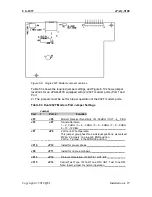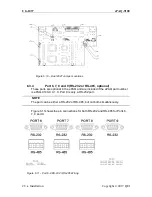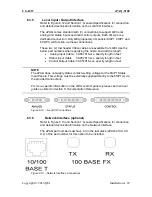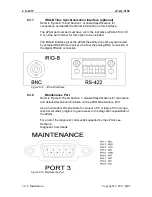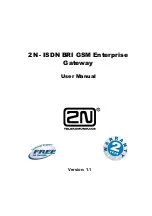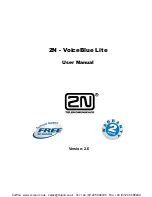
UG-1037
ePAQ-9100
Copyright © 2016 QEI
Hardware Overview
15
The 10/100 Base TX Ethernet interface uses a RJ-45 connector and is Category
5 compliant. The connector is pinned to the 568-A standard and will interface
with any compliant networking hub, switch or router.
The 100 Base FX Ethernet interface utilizes a ST bayonet style connector. The
fiber type is multimode. This interface is compatible with any hub, switch or router
that supports 100 Mbit speeds and multimode fiber communications.
The Ethernet subsystem utilizes a dedicated microprocessor to handle network
communications services.
3.3 Local I/O Interface
This section of the ePAQ-
9100’s hardware provides the interface circuitry
necessary to connect to QEI QUICS 4000 series I/O panels: 6AIP1 (Analog Input
Panel), 6SIP1 (Status Input Panel) and 6COP1 (Control Output Panel). This
interface is divided into three (3) parts: the Analog Panel Interface (API), the
Status Panel Interface (SPI) and the Control Panel Interface (CPI).
3.3.1
Analog Panel Interface (API)
This section allows the ePAQ-9100 to sample differential analog input signals
wired to
the 6AIP1. The API can select up to (8) 6AIP1’s and one of the (16)
inputs on the 6AIP1 for a maximum total of 128 possible analog input points. The
API also includes two fixed reference points at +/- 4.5 Vdc.
The ePAQ-9100 has a 0 to +/- 5Vdc, 12bit A/D converter that converts collected
analog values to digital values. These values are then stored in RAM. A DC/DC
converter in the ePAQ provides power and isolation for the 6AIP1’s.
A 16-pin IDC header (ANALOG) is used to connect the ePAQ-9100 to the
6AIP1’s via ribbon cable.
3.3.2
Control Panel Interface (CPI)
The Control Panel Interface (CPI) provides the means for the system to
momentarily energize external relays (control output points) in response to
control commands received from the "client", or locally generated from internal
processes.
The CPI has the capability of controlling up to 256 momentary relays, or 128
control point outputs. Each control output point consists of one pair of
complementary command functions, such as OPEN/CLOSE, SET/RESET, etc.
Each control output point is normally equipped with an external pair of
momentary relays, or a single electrically or mechanically latching relay. These
external relays are arranged, or grouped, in external control point output panels.
There are several control point output panel arrangements, with the 6COP1
being the most commonly used (most control output panels are groupings of
eight control output points, however some may have only four control output
points). The CPI executes a command by selecting a single external relay, then
energizing its coil for a pre-defined period of time. To do this, the CPI provides 16
current source lines and 16 current sink lines. The current source lines (8 trip and
8 close) act as a relay select, while the current sink lines act as a panel select



























